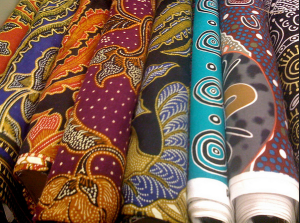Fabric graphics, the new standard in the graphics industry: in retail advertising, tradeshow exhibits, corporate branding, and the world of interior design. Here are the 10 most sumptuous reasons why:
(1) Punchy color The dye sublimation process embeds bold color from water-based dyes into the very fibers of the fabric. The fabric takes in the dyes and is encapsulated into the fibers; pure color through and through, beginning always on a white base. The contrasts traditional methods of printing, which usually calls for a layer of black, which adds density but can muddy up the color.
(2) Sharpness and size flexibility All digital output files sized at 100% final size shows you how large your image can be blown up. The resolution of the final image is only as good as the output file. No longer do images have to hold to the traditional rectangle shape. Images can be made as large as the original output file will allow and the shape is now up to you, depending on the final purpose. Fabric used for printing graphics comes in rolls, not pre-cut sheets. Rolls of fabric can be printed at widths as wide as your printer’s equipment. Grand format images are sewn together to provide enormous sizes as seen in building wraps.
(3) Sustainability and recycling possibilities The dyes are water-based, and the fabrics are polyester-based, some with post-consumer content. Either begin with recycled content or have the waste or used graphic recycled later. There are textile waste recyclers available, but the shipping costs need to come down to make them more accessible to smaller businesses. The more consciousness raised, the more the fabric industry will react using closed loop processing. The more the norm this becomes, the easier it will be for the producers of large format graphics to ship all their waste.
(4) Cleaner process using water-based dyes The simple explanation is there are water-based dyes available to use with this process. With our dye sublimation transfer processing, we choose to use these types of dyes.
(5) Ship-ability, folds down into small packages and costs less Remember the traditional huge rigid panels that had to be carted around, and how big exhibits could travel in many trucks? Moving those huge panels was both cumbersome and expensive. The shipping costs from your booth provider to the advance warehouse and the drayage cost to have the union guys move these heavy panels from the loading dock to your exhibit space was costly. It is still going to cost you, but it will cost a lot less. Most union-run traditional exhibit halls will not likely let you carry your own booth into the halls; unless you got some kind of ‘special permission.’ Ultimately, the carbon footprint from using less trucking services is an improved solution for the environment.
(6) SEG means easy change-outs Silicone gasket strips are sewn into the perimeter edge of the graphic and slipped into a recessed groove of an SEG frame. With buying seasons changing so quickly (Christmas season begins October 1st), the change-outs of retail advertising is made easy with SEG. Regular staff can easily remove and replace a graphic in a matter of minutes, just pull out and pop in. SEG is great for corporate spaces, university campuses, trade show setups, and home decor for seasonal changes as well. The ease of the change out means lower costs for labor.
(7) Short runs of custom fabric now available We all know that once-upon-a-time the only way to get custom fabric was to commit to buying huge runs of the graphic. With digital technology, you can now get onesies for your walls or buy only a few tablecloths for branding at trade shows, rather than a huge volume that likely got wasted. Traditional methods of printing are no longer the only way to go. Recently my company produced a run of custom fabric for the Smithsonian for a Hindi exhibit, which made them very happy. You really could not tell the difference.
(8) High end look The fabric is dimensional, adding texture and character to the room space. Depending on the needs of your project, it can even be draped. Fabric has a presence in a room, that a graphic under glass or under laminate simply does not have. You know the jingle, “cotton, the fabric of our lives,” has a relatable truth that is touchable, accessible, and all around us. Fabric graphics participates in our dimensional space, we can reach out and touch it, and we appreciate the textures we can see. Remember, fabric graphics do not have glare issues because it is not necessary to put glass over top of it. Therefore, you can see it from all angles, all over the room.
(9) Big gain, less pain for trade show exhibit Not to beat an old horse, but the huge rigid panels of yesterday’s trade show are long gone. Putting together a lighter weight aluminum structure or framing system, and stretching fabric over it, is a whole new league of easy, breezy by comparison. Again, the obvious is, less investment in labor to assemble and disassemble. The powerful punch of large format graphics seen from far across the room, created with lightweight fabrics is simply an awesome solution to an old problem!
(10) Washable Not all industries would necessarily require this feature, but know its a possibility. The dyes are embedded and encapsulated, which leaves you with a washable graphic. This is great for traveling trade show exhibits, for any graphic that might have heavy handling and traffic. Anywhere people can brush up against a graphic, its good to know you can wash it. Washing for interior design elements such as drapes, chair and pillow covers, is a wonderful bonus.
And you should know fabric graphics can be frontlit or backlit. They really pop when backlit, and again are a lighter weight solution to the heavier traditional solution sets. So what are you waiting for? Interested? www.photoworksgroup.com or call 1.800.829.4562
Recent Posts
Archives
- September 2016
- March 2016
- December 2015
- November 2015
- October 2015
- August 2015
- July 2015
- June 2015
- May 2015
- April 2015
- January 2015
- November 2014
- October 2014
- August 2014
- July 2014
- June 2014
- May 2014
- April 2014
- March 2014
- February 2014
- January 2014
- December 2013
- November 2013
- October 2013
- September 2013
- August 2013
- July 2013
- June 2013
- April 2013
- November 2012
- October 2012
- September 2012
- August 2012
- July 2012
- June 2012
- May 2012
- April 2012
- March 2012
- February 2012
- January 2012
- December 2011
- November 2011
- October 2011
- September 2011
- August 2011
- July 2011
Categories
- & mounting
- ADA signage
- airport graphics
- Backlit Fabric Graphics
- backlit graphic
- backlit graphics
- blog
- Contour cuts
- digital imaging
- Dye Sub
- Dye Sublimation Graphics
- Fabric Graphics
- fabrication for architects
- finishing
- Finishing services
- Framing
- Giclee
- Large format graphics
- Latex prints
- Lightjet prints
- Lightjet Prints
- Museum Exhibits
- Outdoor banners
- Prints on metal
- Sports Facility Exhibits
- Trade Show Displays
- Uncategorized
- UV Direct Prints


Recent Comments